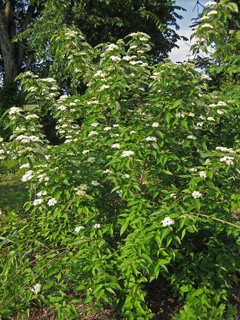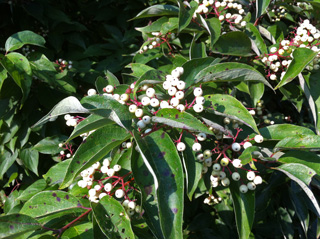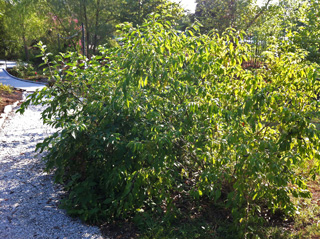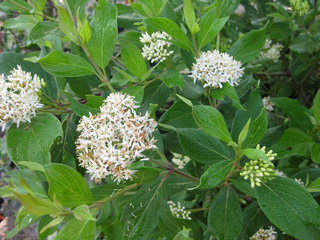Resource Library
Plant of the Week: Dogwoods (Cornus), Shrub (Swida )

Roughleaf Dogwood blooms in late spring and is one of four shrubby dogwoods native to Arkansas. (Image courtesy Gerald Klingaman)
Plant of the Week
Cornus Dogwoods, Shrub Dogwoods, Swida
Every gardener knows dogwood (Cornus florida), but there are almost 60 kinds of dogwoods and, as it turns out, the dogwood everyone knows is the outlier. Most dogwoods, in fact, lack the beautiful white bracts that make it such a showy tree in the spring and have more modest floral displays. We have four of these shrubby dogwoods native to Arkansas.
The genus Cornus is widely distributed across the Northern Hemisphere with a good representation of species in North America, Europe and Asia. Since the time of Linnaeus they have been classified as a single genus with five subsections to accommodate the easily recognized physical differences between the groups. With the use of DNA techniques there is a move afoot to split this long established genus and Arkansas natives such as Cornus drummondii - Roughleaf Dogwood - and Cornus oblique - Silky Dogwood - will be known as Swida drummondii and Swida obliqua. The proposed genus name for the shrubby dogwoods is the Czech name for dogwood.
Four shrubby deciduous dogwoods are found in Arkansas: Cornus drummondii, C. racemosa (Gray Dogwood), C. oblique and C. foemina (Stiff Dogwood). All of these species tend to create their own thicket by means of underground rhizomes, but the first two species are more upright-growing and tree-like, eventually reaching 15 feet in height, while the latter two are more shrub-like and spreading, reaching 10 feet or so in height. The younger stems and branches of silky dogwood will often turn reddish in the winter months but not to the extent seen in some of the redtwig dogwoods selected from species growing further north.

Roughleaf Dogwood has showy white fruit in late summer. (Image courtesy Gerald Klingaman)
The leaves of all of these dogwoods are about 3 inches long with oblong leaves that have the characteristic dogwood vein pattern on the undersurface of the leaves. The veins, as they approach the leaf margin, turn towards the apex and form parallel lines with the margin. As would be expected by the common names, the silky dogwood has a smooth leaf texture while the roughleaf dogwood has a sandpapery texture.
All of the shrubby dogwoods have dense, flat-topped clusters, or cymes, of four-petaled white blooms that appear in late summer. Because they lack the showy bracts of the common dogwood, and because they bloom after the foliage has fully expanded, they are not the show-stoppers generally associated with dogwood blooms.
Roughleaf dogwood and gray dogwood, the two more upright growing species, have clusters of white berries in late summer while the shrubby silky dogwood and stiff dogwood have purple, turning to black berries.
These shrubby dogwoods spread by underground runners, and in the case of the lower growing species, by rooting of the tips of drooping branches. Because of this thicket forming characteristic the shrubby dogwoods often form masses of shrubbery near the edges of streams and the forest edge. They have a preference for moist, bottomland sites.
Our native shrub dogwoods are not commonly grown as ornamentals but instead are used for wildlife plantings - primarily for birds, deer browse or in erosion control projects. If massing is needed in a background situation they can provide a good, trouble-free solution. Though good, tough dependable plants it would be a stretch to call them especially ornamental. Over the years I have seen a number of the ornamental red-stemmed dogwoods from the cool, moist north woods die from crown rot but I have seen no problems from the problem with our native species.
By: Gerald Klingaman, retiredRetired Extension Horticulturist - Ornamentals
Extension News - August 22, 2014
The University of Arkansas System Division of Agriculture does not maintain lists of retail outlets where these plants can be purchased. Please check your local nursery or other retail outlets to ask about the availability of these plants for your growing area.

